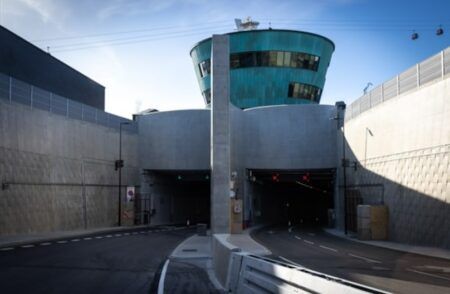Researchers at the University of Michigan (U-M) have demonstrated the effectiveness of connected cruise control (CCC) using vehicle-to-vehicle (V2V) communications to let automated vehicles respond to other road users, helping them all save energy and improve safety.
The U-M team have shown the benefits of the connected cruise control system on public roads, even when just one automated vehicle is moving among human-driven cars. Connected cruise control can adjust a vehicle’s speed based on information obtained through the V2V system, which lets surrounding vehicles wirelessly share data, including their speed and position in real time.
CCC is different from the more widely used adaptive cruise control in that it tracks more vehicles than just the car in front of it. U-M tests on public roads have shown how connected cruise control and V2V between automated and conventional cars can help mitigate the ‘traffic wave’; a common scenario where a chain-reaction of braking and re-accelerating is caused by one car at the head of several others. An automated vehicle using connected cruise control was able to brake with 60% less of the g-force required by a car with a human driver.
The smoother transition from braking to accelerating improved energy efficiency by as much as 19% for the V2V-equipped automated vehicle, surpassing the performance of other non-connected automated vehicles. If onboard sensors are the only source of information for an automated vehicle, when the car immediately ahead hits the brakes, they have little time to respond and may need to brake hard to avoid a potential collision, just like a human driver. The U-M research group carried out a series of experiments V2V-connected automated vehicle received motion information from up to six human-driven vehicles ahead.
In scenarios where severe braking cascaded along a chain of human-driven vehicles, speeds decreased from 55mph to almost zero and then back to 55mph again, with some humans decelerating by up to 0.8g; sending loose objects flying toward the windshield. However, the V2V-based automated driving algorithm maintained a steadier speed profile, gliding through the ripples of rapidly changing traffic. The deceleration of the connected automated vehicle was kept less than 0.3g – not spilling a drop from a full cup of coffee. The research group also found that the V2V-based automated driving algorithm can save energy in stop-and-go traffic compared with traditional sensor-based algorithms, with human-driven cars following the automated vehicle saving up to 7% energy due to the smoother speed profile.
“Automated cars utilizing V2V data will not only perform better, but they can also foster a friendlier environment where few safety hazards sneak into traffic, and higher efficiency is possible for all cars on the road,” said Gabor Orosz, a U-M associate professor of mechanical engineering who led the research. “A significant amount of cars on the road will be equipped with V2V communication devices during the next few years. Most of these cars will still be human-driven, but they will broadcast their motion information. When an automated car encounters these signals on the road, it can see the traffic situation beyond the reach of onboard sensors.”




